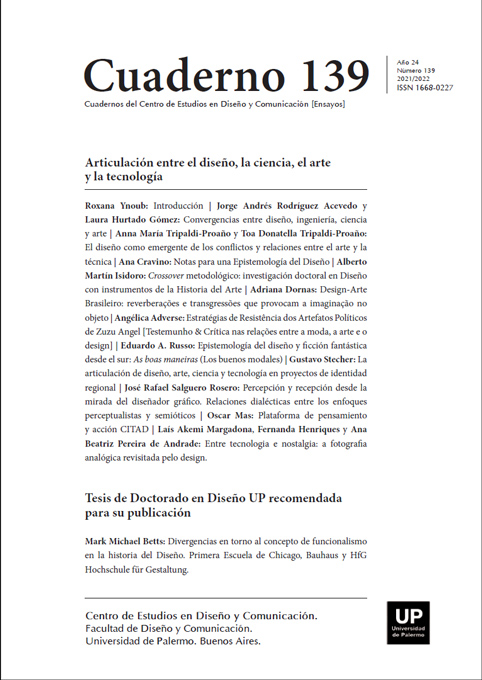Estratégias de Resistência dos Artefatos Políticos de Zuzu Angel
Resumen
Nos anos de 1970, a estilista/designer Zuzu Angel engajou-se em defesa da democracia por intermédio de suas criações. Após o assassinato do seu filho Stuart Angel pela ditadura militar brasileira (1964-1985), ela iniciou intervenções críticas com intuito de denunciar a violência do Estado. Para tanto, concebeu coleções representando os conflitos e a tortura utilizada pelo regime militar contra prisioneiros políticos. Em 1971, realizou um desfile narrando por meio de estampas, bordados e textos, testemunhos sobre a história contemporânea brasileira. O vestido intitulado Anjo tornou-se a peça icônica da coleção a partir da qual ela bordou uma narrativa visual denunciando a necropolítica. A partir dessa criação, analisaremos o artefato político, servindo-nos da pesquisa de Winner (1980) a fim de propor uma correspondência com o Design Crítico. Seguindo as noções apresentadas por Dunne e Raby, analisaremos a ação política e o pensamento crítico no design. Nesse aspecto, nos deteremos sobre o sentido de política por autores como Arendt (2002), Benjamin (2012) e Bensaïd (2008). Por fim, apresentaremos a análise de Disalvo (2012) e Mouffe (2000) a respeito do Design Adverso e o sentido do agonismo. A proposta é pensar como os projetos em Design e Moda de Zuzu Angel transfiguraram-se num confronto político, sendo uma resistência à ditadura militar brasileira. Investigaremos como o estilo de moda possibilitou ao seu trabalho em design subverter as orientações sobre a usabilidade e função. Pelo campo conceitual, Zuzu Angel também aproximou-se das intervenções artísticas,performatizando sentimentos como a perda, a dor e o silêncio.
Citas
Arendt, H. (2002). O que é o política? Rio de Janeiro: Bertrand Brasil.
Benjamin, W. (2012). O anjo da história. Belo Horizonte: Autêntica.
Bensaïd, D. (2008).Penser, Agir. Clamecy: Lignes
Bernward, J. (2012). Do Politics have Artefacts, Social Studies of Science, ISSN 1460-3659, Sage, Thousand Oaks, Vol. 29, Iss. 3, pp. 411-431.
Braga, João (2014). Eu sou a moda brasileira. São Paulo: Itaú Cultural.
Dunne, A.; Raby F. (1997) Hertzian Tales 1994–1997. In: http://www.dunneandraby.co.uk/content/projects/67/0
DiSalvo, C. (2012). Adversarial Design. London: The MIT Press.
Gagnebin, J. M. (1997). Linguagem, Memória e História. São Paulo: Imago.
Groys, B. (2015). Arte Poder. Belo Horizonte: Ed. UFMG.
Latour, B. (2004). PoliticsofNature. Cambridge: Harvard University Press.
Lausen, M.(2007). Design for Democracy: Ballotand Election Design. Chicago: University of Chicago Press.
Manzini, E.; Margolin, V. (2017).Open Letter to the Design Community: Stand Up for Democracy. In:http://www.democracy-design.org/open-letter-stand-up-democracy/
Mbembe, A. (2018). Necropolítica. São Paulo: M-1.
Mouffe, C. 2000. Deliberative Democracyor Agonistic Pluralism. Vienna: Department of Political Science, Institute for AdvancedStudies (IHS).
Quinz, Emanuele (2014). “Objets et Stratégiesdu design Conceptuel.” Strange Design: Du Design des Objetsau Design des Comportaments. Paris: Diffusion.
Schwarcz, L.; Starling, H. (2015). Brasil uma Biografia. São Paulo: Cia das Letras.
Tocqueville, A. (1967). L’Ancien Régime et laRévolution. Paris: Gallimard.
Winner, L. (1980). Do Artifacts Have Politics? Daedalus 109 (1): 121–136.
Zuleika (2014). São Paulo: Itaú Cultural. Nº1, ano 1, abril, p.33 – 63.
Los autores/as que publiquen en esta revista ceden los derechos de autor y de publicación a "Cuadernos del Centro de Estudios de Diseño y Comunicación", Aceptando el registro de su trabajo bajo una licencia de atribución de Creative Commons, que permite a terceros utilizar lo publicado siempre que de el crédito pertinente a los autores y a esta revista.


